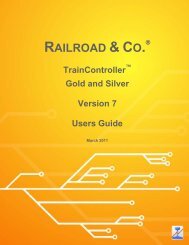Download - Freiwald Software
Download - Freiwald Software
Download - Freiwald Software
Create successful ePaper yourself
Turn your PDF publications into a flip-book with our unique Google optimized e-Paper software.
B<br />
B<br />
142<br />
Release of Blocks and Routes<br />
In general a block or route reserved by a schedule is released when the train has reached<br />
a block ahead of this block/route and when this block/route is not indicated as occupied<br />
anymore. In Diagram 102, for example, block “Main Line East” is not released before a<br />
train coming from “Hidden Yard” has reached “Southtown”. If “Main Line East” is still<br />
indicated as occupied when the train reaches “Southtown”, though, then release of<br />
“Main Line East” is further delayed until the occupancy indication of “Main Line East”<br />
is turned off.<br />
In detail the following rules apply:<br />
• A block is assumed to be reached, when the train reaches a stop indicator assigned<br />
to this block.<br />
• An occupied block or route is not released. (An exception of this rule is outlined below.)<br />
• A block or route is not released until the train has reached a block behind of this<br />
block/route.<br />
• When a train reaches a certain block all not occupied blocks/routes located before<br />
this block, but not located behind another occupied and reserved block/route, are released.<br />
If, for example, “Main Line East” in Diagram 102 is still reserved and occupied<br />
when the train reaches “Main Line West”, then the used block of “Southtown”<br />
is not released, regardless whether it is occupied or not. If both, “Main Line East”<br />
and the related block in “Southtown”, are not occupied when the train reaches<br />
“Main Line West”, then both blocks are released.<br />
• When the train reaches the destination position of the current schedule, i.e. the stop<br />
indicator in a destination block of this schedule, then all blocks and routes apart<br />
from this last block are released, regardless whether they are occupied in this moment<br />
or not.<br />
Simulation of Train Movements without Connection to a Model Railroad<br />
If no digital system is connected, then it is possible to simulate the stimulation of track<br />
sensors by clicking to the related contact indicators on the computer screen with the<br />
mouse. In this way you can perform a trial run of a train on a schedule before the model<br />
railroad is connected.<br />
A very convenient way to simulate train movements is the use of the Traffic Control.<br />
The indicators currently visible in the Traffic Control can be turned on and off by clicking<br />
to them with the mouse, too, if the layout is not connected (see also chapter 6, “The<br />
Traffic Control”).










